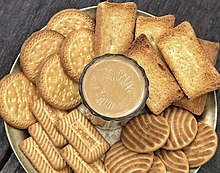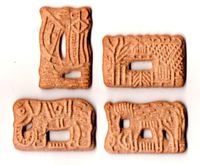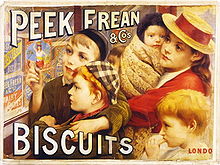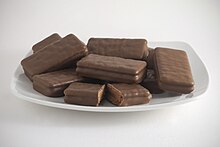Biscuit
 | |
A biscuit, in most English speaking countries, is a
In most of North America, nearly all hard sweet biscuits are called "cookies" and savoury biscuits are called "crackers", while the term "biscuit" is used for a soft, leavened quick bread similar to a savoury version of a scone.
Variations in meaning of biscuit


- In most of the English-speaking world, a "biscuit" is a small, hard baked product that would be called either a "ginger nuts, rich tea, shortbread, bourbons, and custard creams. The term "cookie" typically refers to only one type of biscuit (the sweeter baked dough typically containing chocolate chips or raisins); however, it may also locally refer to specific types of biscuits or breads.[1]
- In the United States and some parts of Canada, a baking soda vs. baking powder which is a mixture of baking soda with an acidifier and buffer). A Southern regional variation using the term "beaten biscuit" (or in New England "sea biscuit") is closer to hardtack than soft dough biscuits.[4]
- In Canada, the term "biscuit" can simultaneously refer to what is commonly identified as a biscuit in either the United Kingdom or the United States. The Canadian Oxford Dictionary describes each word in reference to the other; "biscuit" can mean "Brit. a cookie", whilst "cookie" can mean "N. Amer. a small sweet biscuit". "Tea biscuit" is also a standard Canadianism for the "North American" biscuit.[5]
-
Beaten biscuits (southern US)
-
Wheat and cream biscuits (northern England)
Etymology
The modern-day difference in the English language regarding the word "biscuit" is remarked on by British cookery writer Elizabeth David in English Bread and Yeast Cookery, in the chapter "Yeast Buns and Small Tea Cakes" and section "Soft Biscuits". She writes,
It is interesting that these soft biscuits (such as scones) are common to Scotland and Guernsey, and that the term biscuit as applied to a soft product was retained in these places, and in America, whereas in England it has completely died out.[6]

The
When continental Europeans began to emigrate to colonial North America, the two words and their "same but different" meanings began to clash. The words cookie or cracker became the words of choice to mean a hard, baked product. Further confusion has been added by the adoption of the word biscuit for a small leavened bread popular in the United States. According to the American English dictionary Merriam-Webster, a cookie is a "small flat or slightly raised cake".[10] A biscuit is "any of various hard or crisp dry baked product" similar to the American English terms cracker or cookie,[9] or "a small quick bread made from dough that has been rolled out and cut or dropped from a spoon".[9]
In a number of other European languages, terms derived from the Latin bis coctus refer instead to yet another baked product, similar to the sponge cake; e.g. Spanish bizcocho, German Biskuit, Russian бисквит (biskvit), Polish biszkopt.
In modern Italian usage, the term biscotto is used to refer to any type of hard twice-baked biscuit, and not only to the
History
Biscuits for travel

The need for nutritious, easy-to-store, easy-to-carry, and long-lasting foods on long journeys, in particular at sea, was initially solved by taking livestock along with a butcher/cook. However, this took up additional space on what were either horse-powered treks or small ships, reducing the time of travel before additional food was required. This resulted in early armies' adopting the style of hunter-foraging.
The introduction of the baking of processed cereals, including the creation of flour, provided a more reliable source of food. Egyptian sailors carried a flat, brittle loaf of millet bread called dhourra cake while the Romans had a biscuit called buccellum.[11] Roman cookbook Apicius describes: "a thick paste of fine wheat flour was boiled and spread out on a plate. When it had dried and hardened, it was cut up and then fried until crisp, then served with honey and pepper."
Many early physicians believed that most medicinal problems were associated with digestion. Hence, for both sustenance and avoidance of illness, a daily consumption of a biscuit was considered good for health.
Hard biscuits soften as they age. To solve this problem, early bakers attempted to create the hardest biscuit possible. Because it is so hard and dry, if properly stored and transported, navies' hardtack will survive rough handling and high temperature. Baked hard, it can be kept without spoiling for years as long as it is kept dry. For long voyages, hardtack was baked four times, rather than the more common two.[12] To soften hardtack for eating, it was often dunked in brine, coffee, or some other liquid or cooked into a skillet meal.
The collection Sayings of the Desert Fathers mentions that Anthony the Great (who lived in the 4th century AD) ate biscuits and the text implies that it was a popular food among monks of the time and region.[13]
At the time of the
Confectionery biscuits

Early biscuits were hard, dry, and unsweetened. They were most often cooked after bread, in a cooling bakers' oven; they were a cheap form of sustenance for the poor.
By the 7th century AD, cooks of the
With the combination of knowledge spreading from
As the making and quality of bread had been controlled to this point, so were the skills of biscuit-making through the
Chocolate and biscuits became products for the masses, thanks to the Industrial Revolution and the consumers it created. By the mid-19th century, sweet biscuits were an affordable indulgence and business was booming. Manufacturers such as Huntley & Palmers in Reading, Carr's of Carlisle and McVitie's in Edinburgh transformed from small family-run businesses into state-of-the-art operations.
British biscuit companies vied to dominate the market with new products and eye-catching packaging.[25] The decorative biscuit tin, invented by Huntley & Palmers in 1831, saw British biscuits exported around the world.[25] In 1900 Huntley & Palmers biscuits were sold in 172 countries, and their global reach was reflected in their advertising.[26] Competition and innovation among British firms saw 49 patent applications for biscuit-making equipment, tins, dough-cutting machines and ornamental moulds between 1897 and 1900.[25] In 1891, Cadbury filed a patent for a chocolate-coated biscuit.[25] Along with local farm produce of meat and cheese, many regions of the world have their own distinct style of biscuit due to the historic prominence of this form of food.
Introduction in South Asia

Biscuits and
Modern "hard" biscuits

Most modern biscuits can trace their origins back to either the hardtack ship's biscuit or the creative art of the baker:
- Ship's biscuit derived: hobnobs, Garibaldi.
- Baker's art: Biscuit rose de Reims
Biscuits today can be savoury (crackers) or sweet. Most are small, at around 5 cm (2.0 in) in diameter, and flat. Sandwich-style biscuits consist of two biscuits sandwiching a layer of "creme" or icing, such as the custard cream, or a layer of jam (as in the biscuits that are known as "Jammie Dodgers" in the United Kingdom).

Sweet biscuits are commonly eaten as a
The

Savoury biscuits or crackers (such as
In general, the British, Australians, South Africans, New Zealanders, Indians, Bangladeshis, Pakistanis, Sri Lankans, Singaporeans, Nigerians, Kenyans, and Irish use the British meaning of "biscuit" for the sweet biscuit. The terms biscuit and cookie are used interchangeably, depending on the region and the speaker, with biscuits usually referring to hard, sweet biscuits (such as digestives, Nice, Bourbon creams, etc.) and cookies for soft baked goods (i.e. chocolate chip cookies).[citation needed] In Canada, biscuit is now used less frequently, usually with imported brands of biscuits or in the Maritimes; however, the Canadian Christie Biscuits referred to crackers.[citation needed] The British meaning is at the root of the name of the United States' most prominent maker of cookies and crackers, the National Biscuit Company, now called Nabisco.
See also
- American and British English differences
- Biscuit tin
- Dog biscuit
- Ground biscuit
- Ka'ak
- List of baked goods
- List of biscuits and cookies
- List of shortbread biscuits and cookies
- Rusk
- Biscotti, biscotti regina
Notes
- ^ See, for example, Shakespeare's use of "Twice-sod simplicity! Bis coctus!" in Love's Labour's Lost. (David Crystal; Ben Crystal (eds.). "Love's Labour's Lost". Shakespeare's Words. Penguin Books. Archived from the original on 15 March 2017. Retrieved 15 April 2016.)
References
- ^ "cookie". Oxford English Dictionary. Oxford University Press.
In Scotland the usual name for a baker's plain bun; in U.S. usually a small flat sweet cake (a biscuit in U.K.), but locally a name for small cakes of various form with or without sweetening. Also S. Afr. and Canad.
- ^ "What's the Difference Between Scones and Biscuits?". Allrecipes. Retrieved 17 March 2023.
- ^ "Baking Powder Biscuits Source: U.S. Department of Defense". Theodora's Recipes[sic]. Retrieved 20 December 2013.
- ^ The Food Timeline. Archived from the originalon 4 August 2012. Retrieved 6 January 2021.
- ^ Jet McCullough (2020) "The Great Canadian Baking Show and the 'Biscuit/Cookie' Question". Retrieved 2022-04-29. Queen's University
- ISBN 0-7139-1026-7
- ^ "Biscuit". Oxford English Dictionary. Oxford University Press. 2009.
- ^ "Biscuit". askoxford.com. Archived from the original on 29 December 2004. Retrieved 14 January 2010.
- ^ a b c d "Biscuit". Merriam-Webster. Retrieved 14 January 2010.
- ^ a b "Cookie". Merriam-Webster. Retrieved 14 January 2010.
- Cyclopaedia, or an Universal Dictionary of Arts and Sciences. Vol. I. Ephraim Chambers. 1728. p. 105. Retrieved 3 May 2013.
- ^ page 23, paragraph 20: "At one time Abba Agathon had two disciples each leading the anchoretic life according to his own measure. One day he asked the first, 'How do you live in the cell?' He replied, 'I fast until the evening, then I eat two hard biscuits.' He said to him, 'Your way of life is good, not overburdened with too much asceticism.' Then he asked the other one, 'And you, how do you live?' He replied, 'I fast for two days, then I eat two hard biscuits.' The old man said, 'You work very hard by enduring two conflicts; it is a labour for someone to eat every day without greed; there are others who, wishing to fast for two days, are greedy afterwards; but you, after fasting for two days, are not greedy.'" http://www.g4er.tk/books/sayings-of-the-desert-fathers.pdf
- ^ The National Cyclopaedia of Useful Knowledge, Vol III, (1847), London, Charles Knight, p.354.
- ^ "La Confrérie du Pain d'Epices". Archived from the original on 22 March 2010. Retrieved 4 November 2009.
- ^ Le Pithiviers Archived 30 December 2006 at the Wayback Machine
- ^ "Monastère orthodoxe des Saints Grégoire Armeanul et Martin le Seul". Monastere-saintgregoire.net. Archived from the original on 10 January 2014. Retrieved 10 August 2013.
- ^ "A new neighbourhood in Reading: former biscuit factory to become 765-home district alongside the River Kennet". Evening Standard. Retrieved 19 August 2021.
- ^ "Biscuits". greenchronicle.com. Archived from the original on 3 May 2009. Retrieved 14 January 2010.
- ^ "McVitie's chocolate digestives voted the most popular snack for people working from home". Wales Online. Retrieved 19 August 2021.
- ^ "Britain's top 20 favourite types of biscuit ranked". Wales Online. Retrieved 22 August 2021.
the Chocolate Digestive is the best biscuit in the whole of the United Kingdom with more than two thirds of Brits picking
- Walkersproducts dominate the list of Britain's favourite biscuits
- ^ Pepparkakans historia Archived 10 March 2010 at the Wayback Machine Annas Pepparkakor The history of gingerbread Archived 12 August 2010 at the Wayback Machine Annas Pepparkakor
- Oxford Companion to Food. Oxford University Press.
- ^ a b c d e "History Cook: the rise of the chocolate biscuit". Financial Times. Archived from the original on 10 December 2022. Retrieved 23 August 2021.
- ^ "Huntley & Palmers Biscuits". Victoria & Albert Museum. Retrieved 21 August 2021.
- Cambridge UniversityPress. p. 175.
- ^ "Crunch time: why Britain loves a good biscuit". The Guardian. Retrieved 30 December 2014
- ^ a b "Chocolate digestive is nation's favourite dunking biscuit". The Telegraph. 2 May 2009. Retrieved 28 December 2014.
- ^ "What is the nation's favourite biscuit?" Archived 17 February 2015 at the Wayback Machine. Kernpack. 10 August 2019
- ^ Favourite biscuits. The Express. Retrieved 13 March 2017
- ^ "Cheese Biscuits Source: U.S. Department of Defense". Theodora's Recipies[sic]. Retrieved 20 December 2013.
![]() Media related to Biscuits at Wikimedia Commons
Media related to Biscuits at Wikimedia Commons


